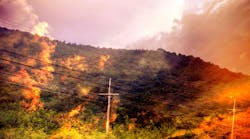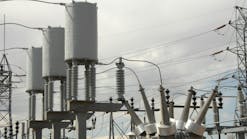In the midst of seemingly unstoppable wildfires in California and western states, can there really be good news for electric utilities in addressing this problem? Surprisingly, the answer is yes. While there are many factors involved in the propagation of major wildfires, our research is showing there is strong consensus on the root cause, which means there are solutions in sight — and that is good news for utilities seeking effective mitigation strategies.
A Consensus on Pole Fire Causation
In a recent survey conducted this summer of 63 utilities across North America by The CIGRE Wildfire Mitigation Working Group along with Exacter, Inc. of Columbus, Ohio, 68% of respondents identified failing overhead equipment as the number-one cause of pole fires on their systems. Specifics included insulator flashover, current tracking across insulators, and the effects on aging wood poles as the current leakage finds its path to ground.
What the research is telling us is this: We, as utility operators, can detect, remove, or at least minimize the prevalence of these grid conditions that represent the number-one root cause: deteriorated insulating equipment. The survey demonstrates that the risk of pole fires that lead to wildfires can be reduced simply by maintaining design standard insulation levels of overhead equipment.
The survey, coupled with our research, identified the ideal conditions for a utility-caused wildfire. On the utility side, dried-wood/charred wood (from current leakage), and the embers emanating from the metal through-hole bolt create the susceptible grid conditions for a fire. From a weather perspective, high winds coupled with dry-to-wet, or wet-to-dry transitions create the perfect climate for ignition and spread of a utility-caused wildfire. This is precisely what we are saw in the fall of 2019, a perfect storm of overhead risks coupled with dangerous weather patterns.
Furthermore, salt, dust, and sediment, sometimes from currently raging fires, can adhere to the surface of overhead components causing dry conductive bands to form on the surface of insulators. These dry bands create susceptible paths for leakage current and dry-band arcing to develop. Eventually this leads to higher current leakage and flashover — establishing the process for the potential of more poletop fires that contribute to wildfires on the ground. This is some of what we are seeing today in the western United States. However, there is a hidden opportunity for mitigation as the dry-band arcing phenomenon develops.
What Utility Operators Are Telling Us
With this research project, we aimed to explore what utility stakeholders knew about the origins, causations, impact, and cost of pole fires, as well as the strategies and methods being used to mitigate them. Some of the things we learned:
- The cost to repair and recover from most pole (63%) fires is between US$10,000-$20,000.
- One in four utilities reported a pole fire that led to collateral damage in the form of a wildfire, or damage to homes, vehicles or property.
- Approximately one in 10 pole fires (11%) will result in some kind of collateral damage.
- Reports from research indicate that some utilities have experienced 500, 1000, even 3000 pole fires in a given year.
Perhaps the most surprising finding from our research was that only 19% of utilities have a specific pole fire prevention plan in place. That doesn’t mean that many of the root causes aren’t being addressed as part of other programs. However, it did reveal that pole fires and collateral damage from them are not singled out as an area of direct focus by more than 80% of the utilities that participated in our survey.
Going Forward with Wildfire Prevention
The good news from our survey and for our industry is that we now know more than we ever have regarding pole fire causation and wildfire mitigation. Most importantly, there is consensus on root causation, meaning we can expect utilities to be investigating new methods, technologies and programs that identify equipment current leakage on their overhead systems so mitigation efforts can occur before the pole fire begins.
While our survey produced no consensus on the months or seasons that pole fires occur across the country, each individual utility and region has their own historical data and trending information as to the seasons to be most vigilant. Using this data, coupled with new and innovative methods for finding root cause conditions, will provide a clear starting point for most utilities to develop specific pole fire mitigation programs.
So, what is the compelling “hidden opportunity"? Research at prestigious academic laboratories like the Ohio State University High Voltage Laboratory confirms that partial discharge emissions from deteriorated, damaged, or contaminated equipment are the most significant indicator of eventual electrical failure. These emissions, which are in the VHF radio frequency bands, have specific signatures that can be identified. The emissions become a herald or indicator of the opportunity to mitigate risk through preventive maintenance. When the strategy is to run-to-failure, the result can be catastrophic under at-risk pole fire conditions. Early identification of dry-band arcing and other partial discharge emissions are an embedded solution to pole fire prevention.


